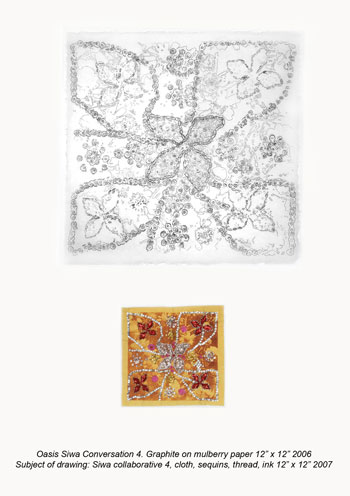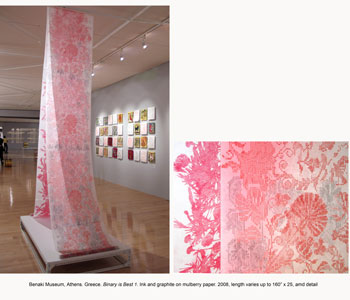Here and There
 |
 |
 |
 |
This February at Whitney Art Works, weave amongst the long, hanging works of Judith Allen-Efstathiou, and stop to inspect the densely rendered guts of security envelopes corsaged with healing plants. In a smaller, more private room, experience Allen-Efstathiou's examination of family, fragmentation, and sentimentality.
In her catalogue essay for the Jill Yakas Gallery, Portland artist, Lauren Fensterstock describes the essence of Allen-Efstathiou's creative integrity. “ If Modernism can be seen as an attempt to escape specific historic and cultural reference, then Judith Allen-Efstathiou's work is utterly in opposition; it is an embracing realm where fragments are precious reminders of moments, of individuals, and the contexts that conspired to cultivate their existence. Formally, her work clearly references Modern ideas. Her subject matter and content, however, dismissively reject the abstract and the universal. She takes a heroic color-field painting and covers it with flowers. She creates a flat composition and fills it with an autobiography of images. Seamlessly marrying Modern compositional elements with individual and culturally loaded imagery, she creates a system of storytelling and identity-building purely her own. “
Allen-Efstathiou deals with juxtaposition in her personal life (splitting her time between Athens and Maine winters) and in her creative life. Her work relies on an interlocking and exchange of "here" with "there" that is visually rewarding and stimulating. "Here and There" is about duality; a show that is bi-national, bilingual, binary, and bilateral.
The main part of the gallery is devoted to the exchange of botanical forms across history and society. Allen-Efstathiou describes how she "printed images of healing plants on fabric and sent them by an intermediary to Oasis Siwa (Egypt) and to Korydallos Prison (Greece) with instructions for the women to embellish my prints in any way they chose. The works created in these collaborations, wrought by numerous hands in a global exchange through a shared language of fabric and ornamentation, became the subject matter for a series of my drawings." Corresponding to this collective approach is a series of elegant, draped drawings inspired by ancient textiles in the Benaki collection. Realistic illustrations of the actual plants are layered with a shimmery translation of these drawings into binary code. Another body of work features obsessively drawn security patterns inside envelopes patterned with an overgrowth of medicinal plants. Though unique, these patterns protect anonymity, while the intertwined plants either infiltrate this opacity or defend against what the envelope, a silent and ubiquitous carrier or harbinger, may represent.
The work tucked into the back of the gallery centers around the theme of family and is titled Rooms of Our Lives: Family as Soap Opera and Mythistorema. While the larger part of the exhibit focuses on a more collective history, for the back gallery Allen-Efstathiou intimately examines and reorganizes her own story. Although her subject matter is self-referential, it never overtly enacts a drama. She culls images from old and new snapshots of people and spaces and connects them to each other. Transformed beautifully by her hand, oblique spaces and moments are imbued with new significance. The artist, Allen-Efstathiou proves, is the ultimate myth maker, DJ ing the optical and cerebral soup and whipping up a breathtakingly familiar but unattached sentimentality.
Places both physical and figurative are colored by myth. The here and there of our personal and collected histories are accumulated like the involved and interlocking threads of tapestry. Warp and weft are a metaphorical in all Allen- Efstathiou's work, as a multidimensional approach that eliminates hierarchy. The result is subject matter that is stretched horizontally and vertically. The artist is pushing in and pulling out the deepest thread in herself and in the places and histories to which she is inextricably linked.
The punch card patterns of a Jacquard loom (the DNA of the most ornate brocades that also happen to look a lot like Allen-Efstathiou's Benaki-inspired drawings) sparked Charles Babbage’s concept of the modern programmable computer in the early to mid-nineteenth century. Similarly Judith Allen - Efstathiou creates multiple applications and connections by rebuilding blueprints and illuminating the symbols, patterns, possibilities and myths that lie latent in her world.
-Celeste Parke
Here and There will be on display from February 5, until March 27, 2010.
Artist Reception: February 5 5-8 PM
Artist Talk: February 11, 12:30
at Maine College of Art Auditorium
Whitney Art Works is open Wednesday - Saturday from 12 - 6pm or by appointment.
© Whitney Art Works, All Rights Reserved. 45 York Street, Portland, Maine 04101 Voice: 207-780-0700
You are viewing the printer-friendly version of Here and There